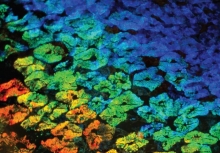Dynamically Tunable and Solar Energy Enhancing Bio-Photonics: Nanoscale Protein Assembly Drives Changes in Reflectance and Photosynthesis, Inspiring New Nano-Technologies

ChEMS Seminar
Professor Daniel E. Morse
Center for Energy Efficiency, Institute for Collaborative Biotechnologies
Department of Molecular, Cellular and Developmental Biology
University of California, Santa Barbara
Nanoscale assembly of members of a unique family of proteins – called “reflectins” – creates high refractive index Bragg lamellae or Mie reflectors within and between specialized cells in the epithelia of certain molluscs. In squids and related species this assembly and the resulting coloration and brightness of reflectivity are tunable, fully reversible, and controlled by neuronal signaling to create a dynamically tunable biophotonic system for underwater optical communication and camouflage. In other species this assembly is fixed, creating permanently bright, broadband (white or silver) or spectrally selective (colored) reflectivity. Among this latter group we discovered a system in giant clams that augments photon delivery to microscopic algae living inside their symbiotic animal host, increasing the algae’s photosynthetic efficiency. This discovery may suggest a blueprint for improvement of nanostructured photovoltaic solar cells. The seminar will discuss details of the varied molecular assembly processes and tunable control, the resulting nanostructures, their photonic properties and technological implications.



(left) Micrograph of living iridocytes in squid skin, photographed as a drop of the neurotransmitter, acetylcholine (ACh), applied at the upper right, diffuses through the tissue, inducing a wave of iridescence proceeding to the lower left and progressing from red to blue. (center) Color change measured micro-spectrophotometrically as a function of time in the tissue at left. (right) Molecular mechanism of neurotransmitter-activated, reflectin mediated tunable changes in brightness and color of light reflected from the tunable iridocytes.
Bio: Dan is the Wilcox Professor Emeritus of Biotechnology, Biomolecular Science and Engineering at the University of California, Santa Barbara (UCSB), and was the Founding Director of the UCSB-MIT-Caltech Institute for Collaborative Biotechnologies, a unique University-Industry-Government collaborative R&D enterprise. He received his B.A. in Biochemistry from Harvard, his Ph.D. in Molecular Biology from Albert Einstein College of Medicine, and conducted postdoctoral research in molecular genetics at Stanford University. Dan’s research is focused at the interface between biotechnology and materials science.
Share
Upcoming Events
-
MSE Special Seminar: Architecting 3D Complex Materials for Sustainability
-
MSE Special Seminar: Decarbonizing Industries for a Climate-resilient Future - From Renewable Energy to Sustainable Material Recovery
-
CEE Seminar: BIM and the Digital Twin
-
MSE Special Seminar: Revolutionizing Battery Technology - Engineering Quantum Materials for Enhanced Safety and Performance in Solid Electrolytes
-
MSE Special Seminar: Designing Sustainable Soft Matter from the Molecule Up
